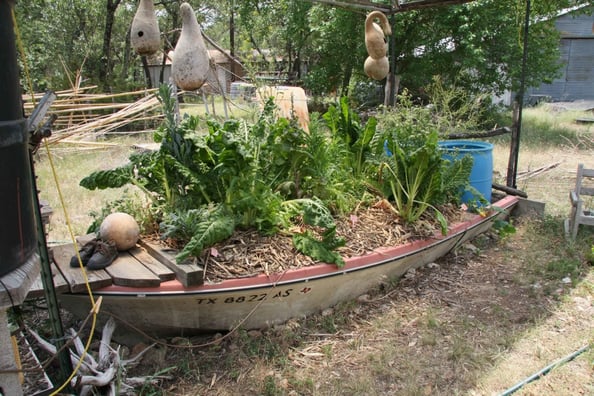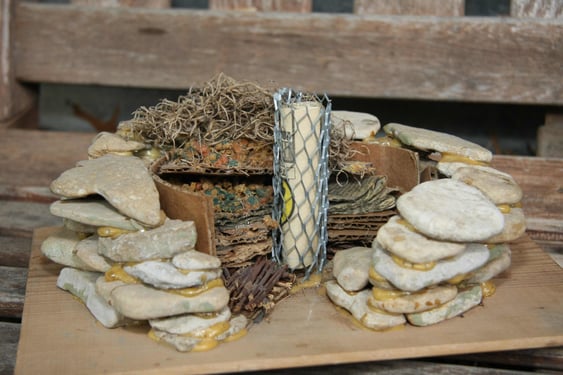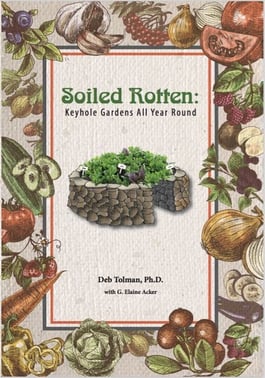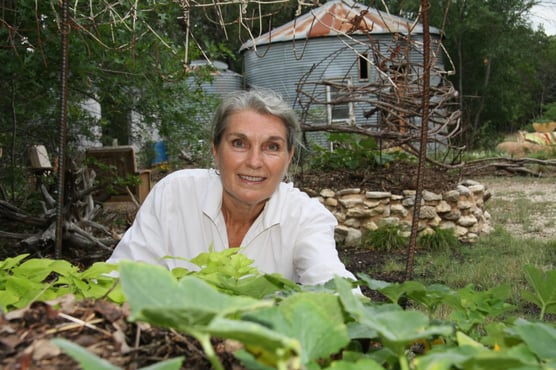Fresh Ingredients from a Keyhole Garden
The Cookbook Creative
I first wrote about keyhole gardening in 2012 in an article for Texas Co-Op Power Magazine. Later, that article became a book, published with Dr. Deb Tolman, who has made keyhole gardening an art form.
A keyhole garden is the ultimate raised-bed planter. It’s six feet in diameter and literally shaped like a keyhole, with a composting basket in the center that leaches moisture and nutrients into the soil.
“The first keyhole garden I did in Clifton, Texas at the Ace Hardware store,” says Tolman. “We used native rock and clay to build the walls, and recycled paper and manure to make soil. In just four weeks, 129 phone books were no longer discernible, and a half dumpster load of cardboard had become soil. The cardboard adds carbon, nitrogen, and air to the soil. It’s gold.”

Tolman eats year-round from her gardens, which are planted in traditional keyhole gardens, or… in an old ski boat or even a bathtub.
“You don’t have to spend $400 a month on groceries when you can grow healthy produce at home,” says Tolman. “In the summertime, I grow Malabar spinach, which loves the heat,” she says. “Chard’s been going all year. I can eat a power snack of French green beans right off the vine.”
Her harvest includes carrots, kale, tomatoes, cucumbers, squash, pumpkins and berries, and rivals the best farmer’s markets in Texas.
“Keyhole gardens aren’t just for gardening experts,” emphasizes Tolman, who instinctively understands how to balance nature’s needs with human needs. “They’re for the gardening-challenged, too. They’re for kids and for seniors. They’re wheelchair accessible.” And, because keyhole gardens can weather the drought and take a bite out of the grocery bill, they’re the gift that keeps giving for seasons to come.
Keyhole Gardening Step by Step
To learn more about keyhole gardening, composting, and other workshops, visit www.debtolman.com.
Here are 10 tips on building your first keyhole garden...
- Measure a six-foot diameter circle to define the inside wall of your garden.
- Notch the circle (like cutting a wedge of pie) so you can access the basket at the center.
- Construct the exterior wall about three feet high using any material that can support the weight of wet soil.
- Use wire mesh to create a one-foot diameter tube about four feet long. Stand the tube in the center of the circle.
- Line the walls with cardboard and fill the garden area (but not the wire mesh tube in the center), with layers of compostable “stuff,” wetting it down as you go. Fill the last few inches with compost or potting soil. The soil slopes from a high point at the top of the center basket downward to the edges of the garden.
- Fill the center basket with alternating layers of compostable “stuff,” along with layers of kitchen scraps and herbaceous weeds that provide the plants with moisture and nutrients.
- Water the center basket, and the garden, only when absolutely necessary. This forces the plants’ roots downward toward the center basket.
- “Feed” the garden with more kitchen scraps, lawn clippings, etc. added to the center basket.
- Consider anchoring a framework of thin wires arching over the garden. During the hottest months, the wires can support a shade cloth, and in winter, plastic sheeting creates an instant greenhouse.
- Enjoy the fruits (and vegetables!) of your labor.
| If you want to read all about keyhole gardening, pick up the book on Amazon! | And if you’re in Texas, don’t miss Dr. Deb’s workshops! | |
 |
 |

